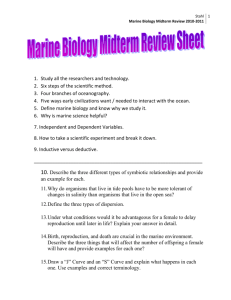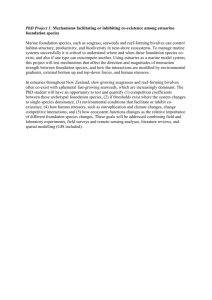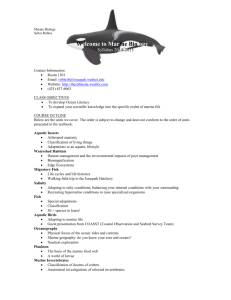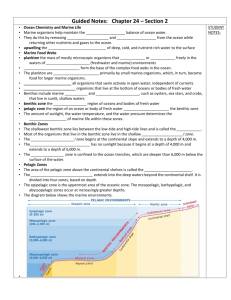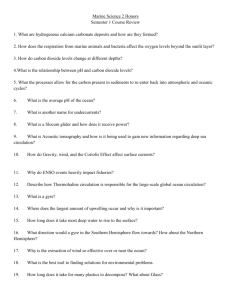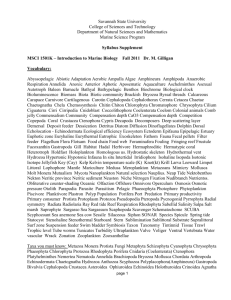Marine Biology Final Exam Review Outline
advertisement
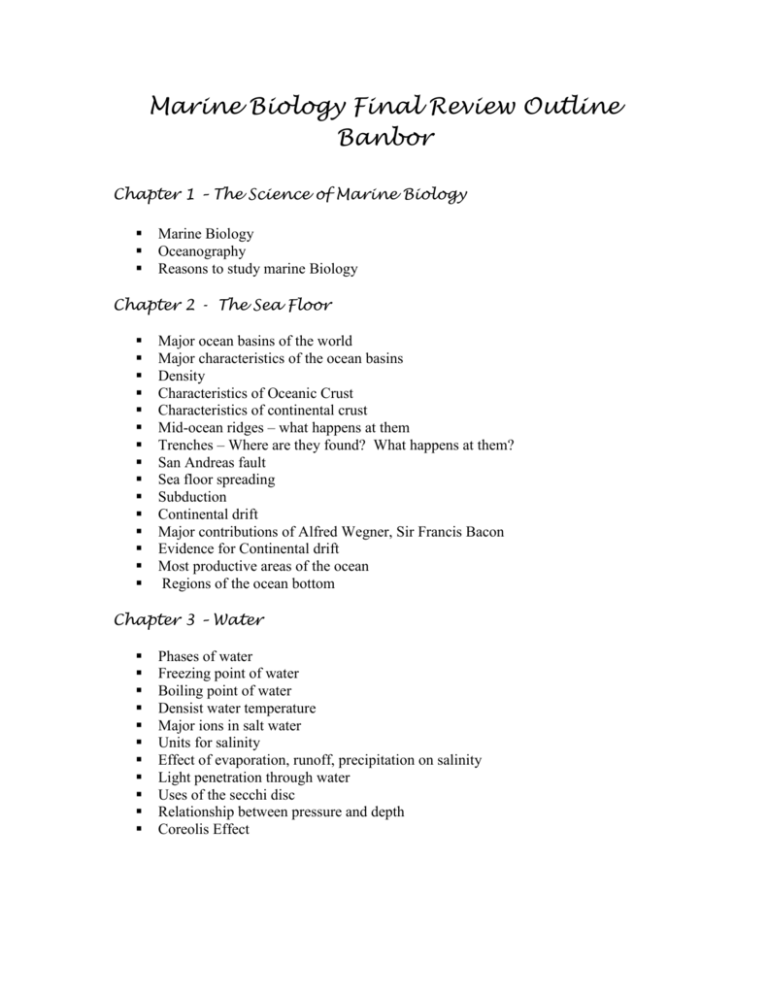
Marine Biology Final Review Outline Banbor Chapter 1 – The Science of Marine Biology Marine Biology Oceanography Reasons to study marine Biology Chapter 2 - The Sea Floor Major ocean basins of the world Major characteristics of the ocean basins Density Characteristics of Oceanic Crust Characteristics of continental crust Mid-ocean ridges – what happens at them Trenches – Where are they found? What happens at them? San Andreas fault Sea floor spreading Subduction Continental drift Major contributions of Alfred Wegner, Sir Francis Bacon Evidence for Continental drift Most productive areas of the ocean Regions of the ocean bottom Chapter 3 – Water Phases of water Freezing point of water Boiling point of water Densist water temperature Major ions in salt water Units for salinity Effect of evaporation, runoff, precipitation on salinity Light penetration through water Uses of the secchi disc Relationship between pressure and depth Coreolis Effect Chapter 10 – Marine Ecology Abiotic vs. biotic factors Community Population Factors that effect population growth Competition Predation Mutualism coevolution commensalism Parasitism Symbiosis Autotroph/heterotroph Consumer/ producer Percentage of energy passed from one level to the next Roles of decomposers Detritus – what is it? Importance? Sessile Plankton Benthos Nekton Omnivore Carnivore herbivore Importance of upwelling areas Chapter 13 – Continental shelf Factors that effect the continental shelf Relationship between sea otters, sea urchins and kelp beds Resources of continental shelves Dessication Eel Grass scientific name Epifauna Infauna Kelp Substarate Subtidal Zone Be able to identify significant organisms of this zone Chapter 15 – Open Ocean Organisms responsible for primary production in the open ocean Adaptations of plankton to stay in the water column Limiting nutrients – most common in open ocean? Zooplankton Phytoplankton Meroplankton Holoplankton Filter feeders – suspension feeders Krill – who eats them? Be able to identify significant organisms of this zone Chapter 8 – Fish Be able to recognize major examples of each class Three classes of fish, major characteristics of each, examples of each Countershading Chromatophores Disruptive coloration Warning coloration Functions of swim bladder, liver, heart, intestine, pancreas, stomach, rectal gland, gills, gill rakers, spiracles, veins, arteries Function of the sharks liver Three types of scales and which fish has each Countercurrent exchange system – how does it work? Body shapes and how they help a fish Function of the claspers Warning coloration Major fins of each fish Tail types and which classes have it Chapter 16 – The Deep Sea Zones of the ocean and major characteristics of each Resources that come from the surface Photophores Adaptations of mesopelagic and deep sea fish Vertical vs. non-migrating fish Function of bioluminescence of the deep sea Pheromones Deep sea hydrothermal vents – where does the energy come from? Chapter 9 – Marine Amphibians, Reptiles, and Marine Mammals Body parts of the sea turtle – characteristics of sea turtles Most dangerous marine reptile Penguins - body parts – uses of each How do marine mammals stay warm Major representatives of order Pinnipedia, Cetacea Difference between seals and sea lions Examples of toothed whales Examples of baleen whales Baleen Major food preferences for each marine mammal group Function of breeching Identify major marine mammals Chapter 7 - Marine Invertebrates Major characteristics of each phylum Examples of each phylum Identify major representatives of each class Chapter 11 – Between the Tides Upper and lower parts of the intertidal Characteristics used to classify intertidal communities How organisms deal with dessication Adaptations to life on the rocky shore Predominate methods of feeding in each intertidal area Limiting resources Vertical zonation – what is it? What causes it? Role of physical and biological factors in organism distribution Chapter 12 – Estuaries How salinity changes in the estuary Salt wedge Types of substrates found in estuaries Euryhaline/stenohaline Major groups of organisms found in estuaries Importance of estuaries The physical factors that effect estuaries Productivity and biodiversity of estuaries as compared to other ecosystems Essay Topics – You will have to do two. • • • • • Plate Tectonics Open Ocean Deep Sea Dogfish Intertidal Zone



